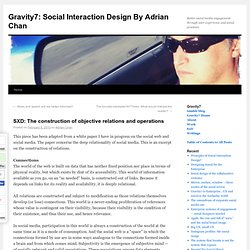

Connectivism: Learning theory of the future or vestige of the pa. Rita KopUniversity of Wales Swansea Adrian HillOpen School BC, Canada Abstract Siemens and Downes initially received increasing attention in the blogosphere in 2005 when they discussed their ideas concerning distributed knowledge.

An extended discourse has ensued in and around the status of ‘connectivism’ as a learning theory for the digital age. This has led to a number of questions in relation to existing learning theories. Keywords: e-Learning; online learning; open learning; distance education; pedagogy; learning theory; educational theory Introduction To what extent do existing learning theories meet the needs of today’s learners, and anticipate the needs of learners of the future? If older theories are to be replaced by connectivism, then what are the grounds for this measure? The Technological Dimension of a Massive Open Online Course: The. Antonio Fini University of Florence, Italy Abstract In 2008, a new term emerged in the already crowded e-learning landscape: MOOC, or massive open online course.

Lifelong learners can now use various tools to build and manage their own learning networks, and MOOCs may provide opportunities to test such networks. This paper focuses on the technological aspects of one MOOC, the Connectivism and Connective Knowledge (CCK08) course, in order to investigate lifelong learners’ attitudes towards learning network technologies. The research framework is represented by three perspectives: (a) lifelong learning in relation to open education, with a focus on the effective use of learning tools; (b) the more recent personal knowledge management (PKM) skills approach; and (c) the usability of web-based learning tools.
Findings from a survey of CCK08 participants show that the course attracted adult, informal learners, who were not concerned about course completion. Background Method. Us_tmt_ce_ShiftIndex_072109ecm.pdf (application/pdf Object) The Call for Connectivity › Connectivity Scorecard. Predicting Tie Strength With Social Media - Social Media Group H. Eric Gilbert and Karrie Karahalios of the University of Illinois at Urbana-Champaign have begun to study how social media can be used to predict tie strength in a sample of 2,184 Facebook relationships: They asked 35 people to rate a number of their Facebook friends that were randomly selected.

Then they looked at the Facebook behavior of these people to see if could accurate predict the strength of their ties as reported by the participants. Dimensions such as the use of words associated with intimacy and intensity, duration of communication, social distance, and other factors were looked at for their predictive power. The complete set of variables was combined to form the predictive model that worked in 85% of the instances. The authors used 74 predictive variables, spanning connection intensity, intimacy, duration, reciprocal services, structure, emotional support, social distance, demographics, and usage: Yankee Group. Social Interaction Design by Adrian Chan: SXD: The construction. This piece has been adapted from a white paper I have in progress on the social web and social media.

The paper concerns the deep relationality of social media. This is an excerpt on the construction of relations. ConnectionsThe world of the web is built on data that has neither fixed position nor place in terms of physical reality, but which exists by dint of its accessibility. This world of information available as you go, on an “as needed” basis, is constructed out of links. Because it depends on links for its reality and availability, it is deeply relational. All relations are constructed and subject to modification as those relations themselves develop (or lose) connections. In social media, participation in this world is always a construction of the world at the same time as it is a mode of consumption.
Operations capture relationsSocial media systems, like any computer-based application, perform a variety of functions. Sometimes a pair remains just a pair. Measuring all-time greatest hits with Google Analytics. Connectedness Helping people link to results.

Friday, November 25, 2005 Measuring all-time greatest hits with Google Analytics Google released its web analytics as a free service about a week ago. I registered as soon as I heard about it, and already I have learned a lot of useful information that I never found through my previous web monitor, SiteMeter. Posted by Bruce Hoppe at 10:12 AM No comments: Post a Comment Newer PostOlder PostHome Subscribe to: Post Comments (Atom) Useful Links Popular archives SNA search engine <font size="-1">check out the <a href=" href=" at <a href=" Connectedness Tag-o-meter bookmark this on Delicious Related blogs SNA Publications. Community networks. WNDR_final.pdf (application/pdf Object) Connectivism: Learning as Network-Creation - 2005.